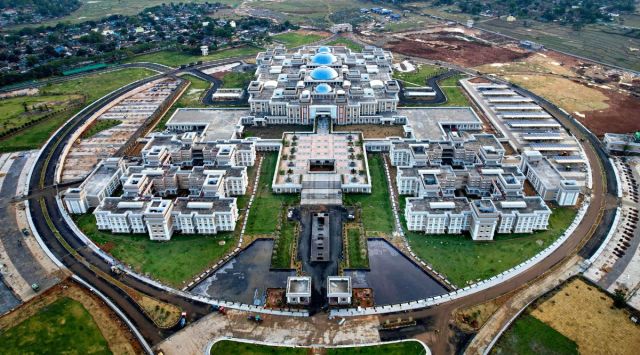President Murmu to inaugurate Jharkhand High Court; know key features of country’s biggest court
The main building complex is built on 72 acres of area and the total campus is around 167 acres leaving scope for future expansion.
 An aerial view of newly constructed Jharkhand High Court in Ranchi. (PTI)
An aerial view of newly constructed Jharkhand High Court in Ranchi. (PTI) President Droupadi Murmu will inaugurate the new Jharkhand High Court, termed as the country’s biggest in terms of area, on Wednesday evening. The building has been constructed at a cost of around Rs 550 crore. The need for the new building arose from the growing numbers of litigants and the vulnerability of the old HC building, which has been operating since 1972 – first as a circuit court and then as a permanent bench of the Patna High Court. Since the formation of Jharkhand state on November 15, 2000, the only bench of the Jharkhand High Court operated from the old HC building.
“The building was conceptualised in 2013, but the work started in 2015, but there were certain hiccups in between. However, in the last two years, the construction took place and we completed more than 60% of the entire construction,” Building construction secretary Sunil Kumar told The Indian Express
What are the top salient features of the new High Court building:
# The main building complex is built on 72 acres of area and the total campus is around 167 acres leaving scope for future expansion. The complex comprises an auditorium, conference rooms, committee meeting halls, and a separate building for advocate general and government counsels. The new HC has a capacity of more than 4,300 people including judges, residential judges, lawyers and visitors.
# It has 25 air-conditioned court blocks which will include the judge’s chamber, one ante room, one personal assistant room and one waiting room. In addition, the Chief Justice Block will also include a video conference room, kitchen, dining hall and conference hall. There will be a separate 12 conference room for the judges and 10 chambers for the registrars and four court offices. In addition there will be a sitting lounge, a judge’s library, oath commissioner’s chambers, different cells, chambers, one kitchen and one canteen.
# Among additional buildings there will be two typist blocks, one dispensary, one amenities block, 70 men barracks (for security personnel), and four watchtowers. 500 CCTV cameras have been installed too. There is a parking capacity of 2,000 vehicles.
# There will be one Advocate General’s chamber, conference hall and a library. Three chambers for the Deputy Advocate General, and 95 chambers for Additional Public Prosecutor and other law officers.
# Among the facilities for the advocates, there will be a central lobby of 14,000 square feet, separate recreation halls for men (two) and women lawyers (one), four halls for advocate clerks, and a Bar room. Two halls for advocates with a seating capacity of 1,660 people, 76 senior advocate chambers with toilets and pantry attached and 369 advocate chambers. Two kitchens and two canteens have been constructed for lawyers.
# In the green building measure, solar panels have been installed. “We have installed a 2,000 KVA solar system which will cater to 40 per cent of the electricity needs,” secretary Sunil Kumar said. More than 4,400 saplings have also been planted.
# It is estimated that the water requirement in the HC will be 353 Kilo Litres per day (KLD) which will be initially met through the municipal supply. The total fresh water requirement will be 193 KLD for domestic water requirements among others. The water requirement for flushing, landscaping among others will be met through treated water from STP, which has a capacity of 200 KLD.
# It is estimated that the solid waste generation would be at a maximum of 700 kilograms per day and more than 120 kilograms of sludge.







